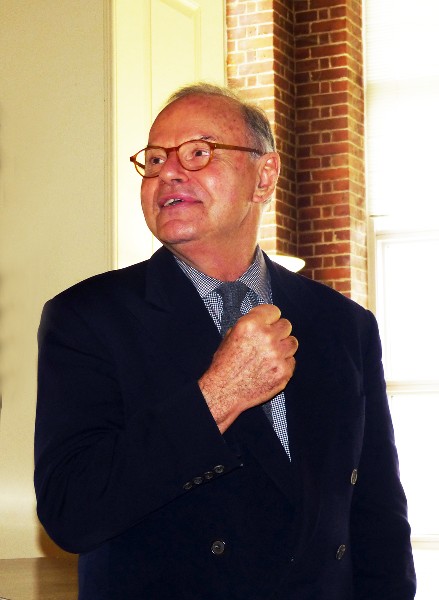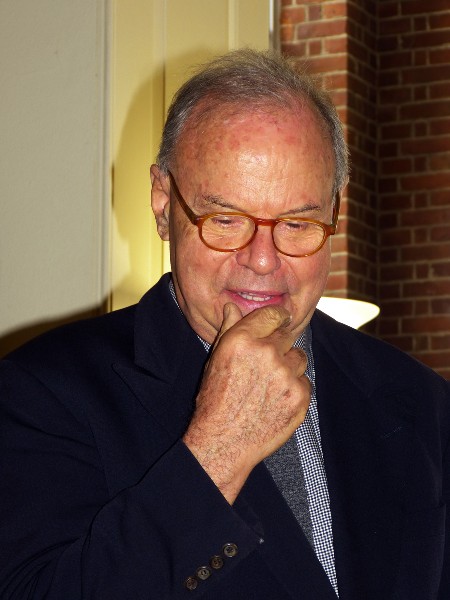The Clark's Masterpieces Home at Last
On Tour to Eleven Venues on Three Continents for Three Years
By: Charles Giuliano - Mar 21, 2014
Imagine visiting the Louvre and finding that “Mona Lisa” is not at home. Or The Prado and discovering that “Las Meninas” is on tour. Consider arriving at The Accademia Gallery in Florence only to learn that Michelangelo’s “David” is on extended loan in the lobby of the Bellagio in Las Vegas.
Is that a stretch of the imagination? Probably. But is it possible? Absolutely.
With the belt tightening of public and private funding and ever increasing costs museums have initiated adventurous and drastic strategies to raise operating and expansion capital. Bottom line that means a dramatic increase of masterpieces on extended loans to traveling exhibitions or through contracts with satellite museums.
Museums securing loans for their ambitious exhibitions and loaning to others has always been a high stakes poker game. You have to be willing to give in order to receive. Since the 1970s, however, major museums also have loaned to non institutional, for profit, exhibition organizers. The focus increasingly is on the bottom line rather than aesthetics.
During a press conference this week Michael Conforti, the director of the Sterling and Francine Clark Art Institute, said that “Our collection is coming back this summer having visited eleven sites around the world over the past three years. Some 2.6 million people have visited these exhibitions and heard about the Berkshires. The Clark has been a great ambassador for the Berkshires.
“We have brought these objects to four or five sites in Asia including Shanghai. It was the second most visited exhibition for the Shanghai Museum. It was the fourth most visited exhibition at the Prado Museum in Madrid. There were three of four sites in Europe and three or four sites in North America. Now it is coming back here.”
The Clark is closed for reinstallation with a scheduled reopening on July 4.
When museums shut down for extended periods of time for renovation and expansion it is the norm to send works on tour. These loans generally result is agreements to borrow reciprocal works once the museum reopens.
For the Clark that will happen as soon as this summer with a collection of Ancient Chinese bronzes from the Shanghai Museum. Over time we may anticipate major loans from the Prado and the other major Asian, European and American museums that participated in the Clark’s touring exhibition of its masterpieces.
Some years ago when the Museum of Fine Arts Boston was undergoing renovation it sent its great collection of works by Boston artist John Singleton Copley to the Philadelphia Museum of Art. Later the MFA hosted a superb exhibition of works by Philadelphia’s greatest artist Thomas Eakins. That’s the way it should be done.
The Barnes Foundation went to court to overcome an iron clad will to send its collection on tour and relocate from an inaccessible suburban location to downtown Philadelphia. Dr. Barnes, who founded the institution, had specific and peculiar rules about how the collection was to be displayed and who would have access to it. In particular he banned art critics and known art historians. You had to make an appointment to visit the museum. That continues to be true. Art critics were known to pose as plumbers in order to see the collection. As we found out that’s no longer necessary.
The Barnes was in financial distress when the dramatic decision to relocate was made. The tour of the collection helped to fund the new building. Its galleries replicate the original building and the salon style installation, with state of the art climate control and lighting. The collection has been rehung in the eccentric configuration of Dr. Barnes to a tolerance of a fraction of an inch.
The three year, multi-continental tour would seem to be a win win for the Clark.
But such a massive undertaking comes with significant risk factors. There are enormous insurance and handling charges. Curators and conservators must be present on each stop of the tour as works are crated or unpacked. Meticulous records and condition reports are kept.
During the press conference this week Astrid Hiemer of Berkshire Fine Arts asked if during the extensive tour there had been any damage to the works?
Conforti answered that he had anticipated the question and introduced chief curator Richard Rand. Before Rand spoke Conforti commented “You simply can’t imagine the level of oversight. Considering that this is the cultural patrimony of the region it’s not been easy.”
Rand said “It’s a very important question. In talking about this world tour we decided to only work with institutions which had great standards. Partners we knew or got to know. That was foremost. Institutions that would have great benefits for the Clark and the Berkshires in all kinds of ways.
“For our Renoirs eleven stops over three years is a lot of wear and tear. We had concerns but we prepared well. All of the pictures were put under glass. We would never show them at the Clark under glass because we want people to see them up close. But for a world tour we wanted to protect them. In many of the venues as we were packing up we found finger prints on the glass. So we came to realize it was a smart thing to protect our pictures in this way.
“At every stop our registrars and staff would go with the pictures. There were at least four people with every shipment between venues including two registrars and at least two other staff members. They oversee the dismantling of the exhibition working with local crews who are professional art handlers. Everything was put in double crates which are professionally made to our standards. The condition of each picture is recorded and noted. We have very specific notes. It takes many minutes to make each report. We noted every little change.
“We didn’t have much trouble with the paintings. There was one painting that after several stops we were not happy with what we saw happening on the surface. We took it out of the show which was something we had decided early on. If there was any problem with a painting we would take it out. We had some issues with framing. That always happens but we had conservators as we went along.”
Conforti asked “How many air flights were there?”
“We broke it up into four shipments” Rand said. “We did that because of the value.”
“Kuala Lampur” Conforti said in a reference to the plane that was lost in a flight from Malaysia to Beijing.
“We divided it up by value” Rand said. “So every shipment would have a certain value. We were not going to send all of our Renoirs, for example, on one flight. Overall it went very well and there were no problems which were not anticipated. That was testimony to a wonderful staff and oversight on our part.”
That is also a reflection on the most advanced technical advances in the field of professional art handling. This has increased relevance as more and more museums have loaned masterpieces, not just for the quid pro quo of negotiating reciprocal loans but as a source of revenue.
This trend, which has been the subject of controversy and concern, actually started in the Berkshires with former Williams College Museum of Art director Tom Krens. He represented a new breed of museum director. Unlike traditional museum directors who were trained as art historians Krens combined an MFA studio degree and an MBA.
When we met more than 20 years ago to discuss his plans to transform the abandoned Sprague Electric campus into Mass MoCA he described the critical mass of works in storage. He talked about how museums are only able to show a relatively small percentage of what they own. Major private collectors have to warehouse their works. His concept for Mass MoCA was to display these works that would otherwise languish in storage.
He took this concept to the Solomon R. Guggenheim Museum of Art when he became its director.
In 1991, the Basque government suggested to the Solomon R. Guggenheim Foundation that it would fund a Guggenheim museum to be built in Bilbao’s decrepit port area, once the city's main source of income. The Basque government agreed to cover the US$100 million construction cost, to create a US$50 million acquisitions fund, to pay a one-time US$20 million fee to the Guggenheim and to subsidize the museum's US$12 million annual budget. In exchange, the Foundation agreed to manage the institution, rotate parts of its permanent collection through the Bilbao museum and organize temporary exhibitions. The museum opened in 1997 and remains a strong focus for the city and region.
This would be the first of several more satellite museums including venues in Berlin and Las Vegas now closed. Prior to Krens the foundation had a long and continuing association with the Peggy Guggenheim Museum in Venice.
Eventually it became ever more complex and expensive for the Guggenheim to maintain its Milky Way of museums. The system sprung a leak and Krens was ousted by a board focused on reaffirming the primacy of the New York museum and its programming.
In 1999, two years after Bilbao, the Museum of Fine Arts opened a satellite museum. What follows is an excerpt of a recent MFA press release.
“In April 2014, Japan’s Nagoya/Boston Museum of Fine Arts (N/BMFA) and the Museum of Fine Arts, Boston (MFA), celebrate the 15th anniversary of America’s first and only sister museum in Asia. Throughout the partnership, which has welcomed more than 4 million visitors to the N/BMFA since 1999, numerous exhibitions have brought Boston’s artistic treasures to Japan.
“To mark the anniversary, and celebrate the Museum’s historic relationship with Japan, the MFA has organized Millet, Barbizon and Fontainebleau, which is on view in Nagoya April 19–August 31, 2014. A highlight of the exhibition, Jean-François Millet’s masterpiece The Sower (1850), will travel to Japan along with a number of important works from the MFA’s renowned collection of French paintings from the mid-19th century. In Japan, Millet, Barbizon and Fontainebleau also travels to the Museum of Art, Kochi, and the Mitsubishi Ichigokan Museum, Tokyo. Additionally, a series of special events and programs in Nagoya surrounding the 15-year anniversary includes a Directors' Dialogue with Dr. Shunkichi Baba, Director of the N/BMFA, and Malcolm Rogers, the MFA’s Ann and Graham Gund Director.
“This exhibition of 64 paintings displays one of the world’s premier collections of landscape art from 19th-century France, and features artists including Millet, Camille Corot, Narcisse Virgile Diaz de la Penã, Théodore Rousseau and Claude Monet. Exploring Millet’s career and influence on his contemporaries, the show also examines the artistic heirs to the Barbizon School. In addition to The Sower, Millet’s Young Shepherdess (about 1870–1873) will travel from Boston to Japan, bringing two of the artist’s large, iconic portraits of rural life to Nagoya.
“Founded by The Foundation for the Arts, Nagoya (FAN), the N/BMFA was established in 1999 as the MFA’s sister museum. Together, the museums have pursued the common goal of sharing a comprehensive view of world art from across all cultures and time periods with the people of Japan. Since its opening, when the 20-year partnership (1999–2019) was launched, the N/BMFA has presented close to 40 major exhibitions organized by the MFA, sharing close to 4,000 works from the Boston Museum’s collection. The N/BMFA has also become an integral part of the vibrant community life in Nagoya—a center of commerce and industry in the heart of Japan.”
While Krens described getting works out of storage and on view that has happened in a manner that he did not anticipate. Of the 4,000 works from Boston shown in Japan the majority have been first class works. Particularly from the museum’s renowned collection of 19th century French Impressionist masters. So the works from the basement have mostly been hung by the MFA to fill holes in its permanent collection galleries.
During my years as a professor of art history each semester I organized tours of the MFA galleries. If I had fifty students in my group by the time we reached the impressionist galleries there were a couple of hundred tagging along. They even asked questions or cornered me after the tour.
Part of the success of those museum lectures came from knowing what to expect in the next gallery. Now apparently that is no longer possible. The greatest masterpieces may be on the road for years at a time.
This is an issue that Sebastian Smee has covered extensively for the Boston Globe. Here are some excerpts from a November 25, 2012 article.
“Visitors to the Museum of Fine Arts this holiday season can see the celebrity and fashion photographs of Mario Testino. But if they wander off into the permanent collection galleries, they won’t find the museum’s most famous Renoir, “Dance at Bougival.” Nor will they see any of the MFA’s five paintings by Cezanne, five of its six great painting by Edouard Manet, its most distinctive Monet (“La Japonaise: Camille Monet in a Japanese Costume”), or its two greatest Van Goghs (“Postman Joseph Roulin” and “Lullaby: Madame Augustine Roulin Rocking a Cradle [La Berceuse]”).
“Some of these works have been lent to serious and scholarly museum shows in the United States, Japan, and Europe. Agreeing to such loans is common practice, and builds goodwill for when the museum asks to borrow for its own exhibitions.
“However, the MFA, eager to raise revenues, is also renting out many of its most prized works of European and American art to for-profit enterprises. A total of 26 paintings, including the marquee “Dance at Bougival” and “Madame Roulin,” have been sent to exhibitions in Italy organized by a private company called Linea d’Ombra, for a large, undisclosed fee...
“Linea d’Ombra is run by art historian-turned-entrepreneur Marco Goldin, an impresario who has been dubbed the “King Midas of the art world” by newspapers in Italy. During the past decade, Goldin has found success persuading northern Italian cities to pay steep fees to mount popular exhibitions of borrowed artworks…
“In the meantime, visitors to the MFA can be dismayed to find its most famous paintings missing. Other absent masterpieces include Velazquez’s “Luis de Gongora,” two of the MFA’s three great El Grecos, two of its Courbets, its only major painting by Edvard Munch, and arguably its greatest Degas, “Edmondo and Therese Morbilli.”
Smee’s concerns are well taken.
With the Clark closed for years of renovation and construction Conforti took the opportunity to parade the relics. As he and Rand stated every technical and administrative precaution was taken. They only partnered with museums representing the highest standards. After three years and eleven venues the collection has returned safe and sound.
The tour of masterpieces has enhanced the museum’s global reputation. There is a combined benefit of increased future tourism as well as favors to call in for loans of masterpieces. This grand tour will reap benefits for years to come.
That’s the right way of doing things.
The Guggenheim under former director Krens and the MFA under now retiring director, Malcolm Rogers, represent another more controversial approach. The Guggenheim appears to be back on track with its primary focus. The trustees of the MFA will have to conduct some soul searching as they look to replace their P.T. Barnum oriented director and the three ring circus he leaves behind.
Surely Rogers accomplished much. But frustrated visitors to the museum often found that, like Willie Loman, the greatest works were out on the road paying the bills.






